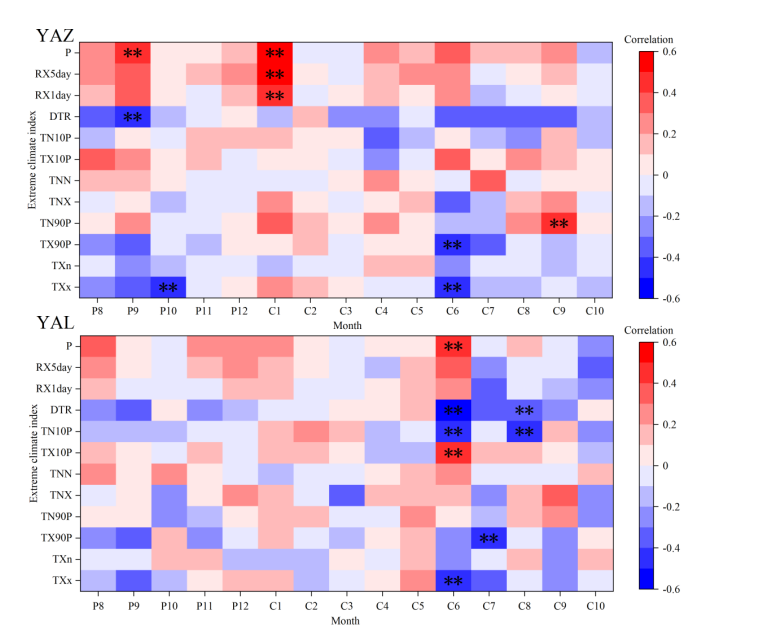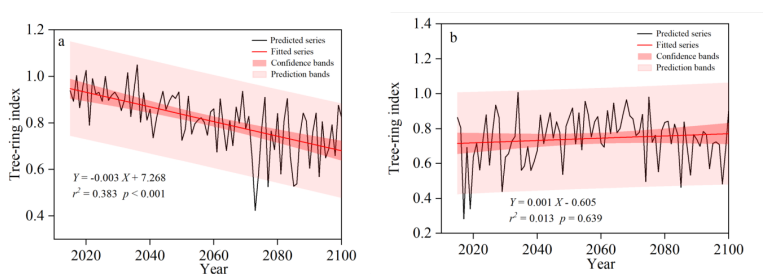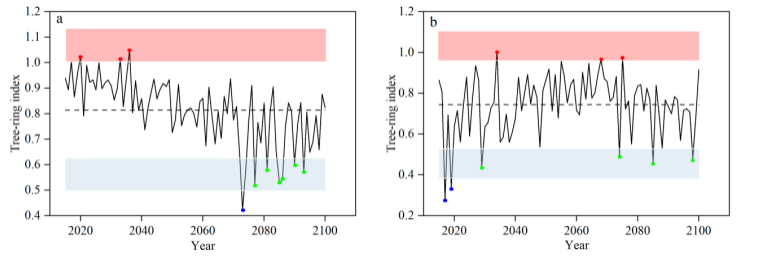
Research Highlight

Forest ecosystems are highly sensitive to global climate change, and the increasing frequency of extreme climate events poses significant challenges to tree growth and forest sustainability. As a vital ecological barrier in Northeast China, the Daxing'anling Mountains have drawn considerable attention regarding how their forest ecosystems respond to extreme climate conditions. Recently, the tree-ring research team at the Desert Meteorology Institute conducted a comprehensive study on the radial growth responses of Pinus sylvestris var. mongolica and Larix gmelinii to extreme climate events in the northern Daxing'anling region, providing critical scientific insights for adaptive forest management.
The research team analyzed tree-ring width chronologies of Pinus sylvestris var. mongolica and Larix gmelinii (1952–2015) alongside extreme climate indices from the study area. Using Pearson correlation analysis and LASSO regression modeling, they revealed complex relationships between tree growth and extreme climate conditions. The study found that the radial growth of Pinus sylvestris var. was significantly negatively correlated with extreme high-temperature indices but positively correlated with extreme precipitation, exhibiting a lag effect. In contrast, Larix gmelinii showed greater sensitivity to extreme cold events. These differences were primarily attributed to species-specific traits.
By applying the CMIP6 model under the SSP2-4.5 scenario, the team projected future growth trends for both species from 2015 to 2100. The results indicated a significant decline in Pinus sylvestris var. growth (at a rate of -0.03 per decade), with an increase in abnormally low-growth years. While Larix gmelinii exhibited no significant trend initially, a potential decline was observed after 2075. These variations were linked to the combined effects of rising extreme temperatures and reduced precipitation in the future.
This study represents the first comprehensive assessment of the response mechanisms and future risks of dominant tree species in the Daxing'anling Mountains under extreme climate conditions, offering essential data for forest conservation strategies. Moving forward, the research team plans to integrate multi-model simulations and ecosystem dynamics to further explore the impacts of extreme climate on forest carbon cycling.

Fig 1:Correlation between monthly extreme climate indices and the standard chronologies of P. sylvestris (YAZ) and L. gmelinii (YAL). ** denotes: P < 0.01

Fig2:Growth prediction of P.sylvestris (a) and L. gmelinii (b) under SSP2-4.5 emission concentration scenario from 2015-2100. The black line represents the predicted series, the red line is the fitted series, and the shaded region represents the 95% confidence bands and prediction bands.

Fig3:The growth trend and characteristics of P.sylvestris (a) and L. gmelinii (b) under the SSP2-4.5 emission concentration scenario. Red area: 1.5*SD< y <2.5*SD; Blue area: -2.5*SD < y <-1.5*SD; Red spot represents abnormally high value, green spot represents abnormally low value, and blue spot is extremely abnormally low value.
The findings were published in Geochronometria under the title "Response of Radial Growth of P. sylvestris var. mongolica (P. sylvestris) and Larix gmelinii (Rupr.) Kuzen (L. gmelinii) to Extreme Climate and Their Future Growth Trends in the Daxing'anling Mountains, Northeast China." The first author of the paper is Dr. Ruxianguli-Abudureheman, an assistant researcher at the Desert Meteorology Institute, with Dr. Tongwen Zhang serving as the corresponding author. The study was supported by the National Key R&D Program of China (2023YFE0102700), the Outstanding Youth Science Foundation of Xinjiang (2022D01E105), and the Desert Meteorology Scientific Research Fund (Sqj2023003).
Citation:
Abudoureheman, R., Zhang, T., Yu, S., Zhang, R., Shang, H., Liu, K et al, (2024). Response of radial growth of P. sylvestris var. mongolica (P. sylvestris) and Larix gmelinii (Rupr.) Kuzen (L. gmelinii) to extreme climate and their future growth trends in the Daxing’anling Mountains, northeast China. Geochronometria, 51(1), 192337.
https://doi.org/10.20858/geochr/192337

0991-2652429

desert@idm.cn

新疆维吾尔自治区乌鲁木齐市建国路327号


Scan to follow
us on WeChat